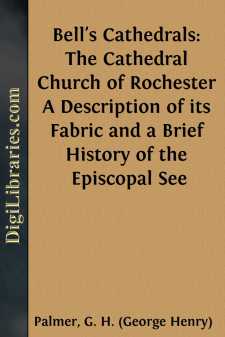Categories
- Antiques & Collectibles 13
- Architecture 36
- Art 48
- Bibles 22
- Biography & Autobiography 813
- Body, Mind & Spirit 142
- Business & Economics 28
- Children's Books 15
- Children's Fiction 12
- Computers 4
- Cooking 94
- Crafts & Hobbies 4
- Drama 346
- Education 46
- Family & Relationships 57
- Fiction 11829
- Games 19
- Gardening 17
- Health & Fitness 34
- History 1377
- House & Home 1
- Humor 147
- Juvenile Fiction 1873
- Juvenile Nonfiction 202
- Language Arts & Disciplines 88
- Law 16
- Literary Collections 686
- Literary Criticism 179
- Mathematics 13
- Medical 41
- Music 40
- Nature 179
- Non-Classifiable 1768
- Performing Arts 7
- Periodicals 1453
- Philosophy 64
- Photography 2
- Poetry 896
- Political Science 203
- Psychology 42
- Reference 154
- Religion 513
- Science 126
- Self-Help 84
- Social Science 81
- Sports & Recreation 34
- Study Aids 3
- Technology & Engineering 59
- Transportation 23
- Travel 463
- True Crime 29
Bell's Cathedrals: The Cathedral Church of Rochester A Description of its Fabric and a Brief History of the Episcopal See
Categories:
Description:
Excerpt
CHAPTER I.
Long, eventful, and very interesting is the history of the cathedral, or rather of the successive cathedrals, of the ancient city of Rochester. It is many centuries since, in 597, St. Augustine and his fellow missionaries landed on the coast of Thanet, almost on the very spot where Hengist and his bands had disembarked nearly one hundred and fifty years before. Hengist’s descendant, Ethelbert, King of Kent, received them in the open air on the chalk downs above Minster, and, though he would not at once renounce the faith of his fathers, promised them shelter and protection. His conversion occurred a year later, and after that Christianity spread rapidly among his subjects. The royal city of Canterbury continued to be the centre of St. Augustine’s labours, but only seven years passed, Bede tells us, ere he deemed it necessary to found other sees at Rochester and at London. Rochester therefore claims to be the second, or at most the third oldest of English bishoprics.
Justus, one of the band sent by St. Gregory to help the mission in 601, was consecrated as its first bishop in 604. A church was built for him by the king and dedicated to St. Andrew, the patron saint of the monastery on the Cælian Hill in Rome, from which St. Augustine and his companions had come. Bede relates that St. Paulinus was buried in it, later, “in secretario beati apostoli Andreæ quod rex Edilbertus a fundamentis in eadem Rhofi civitate construxit.” Ethelbert endowed it with Priestfield (a large tract of land lying towards Borstal) which still belongs to it, and with other property; and Justus, though himself a monk, placed it in the hands of secular priests.
All traces of this Saxon cathedral disappeared long ago, and its exact site was forgotten and remained unknown until portions of its foundations were discovered in 1889, during the underpinning, preparatory to restoration, of the present west front. Beneath this front, but only for a little way within it, the older foundations extended. They were of hard concrete, from 4 to 5 feet deep and wide, and still carried fragments of the walls, about 2 feet 4 inches wide, of tufa, sarsen, and Roman brick. These remains, on examination, proved to have belonged to the east end of a building, which, in this direction, terminated in an apse that occupied almost the entire width. The southern junction of this apse was found first within the present church; and later, in lowering a gas main under the road outside, the north-east corner of the nave was discovered. The internal width of the building was then ascertained to be about 28 feet 6 inches. The lines of the north and south walls were followed by means of a probe across the old burial ground westwards as far as the road, running from the High Street to Boley Hill, and the foundations of the west wall lying along its side. These researches revealed no signs of aisles, quasi-transepts, or porch. If a western porch or apse ever existed, and has left any remains, these remains must lie beneath the road, so that excavation would be necessary to get at them....


